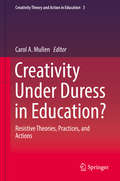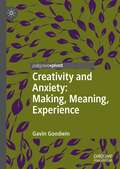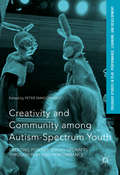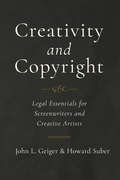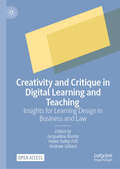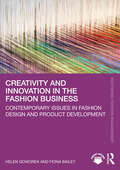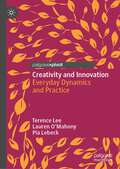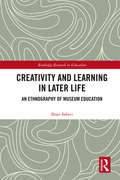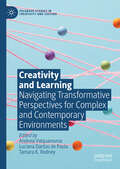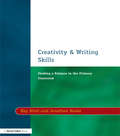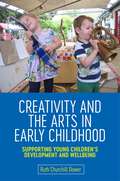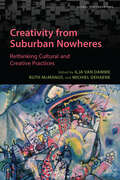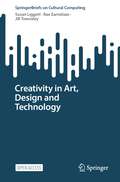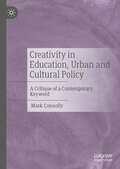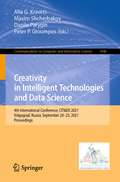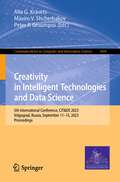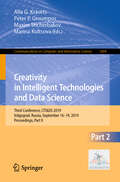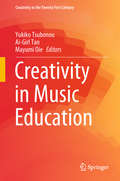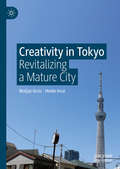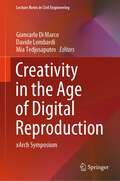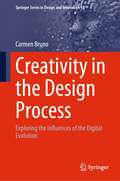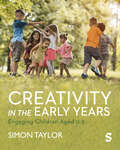- Table View
- List View
Creativity Under Duress in Education?: Resistive Theories, Practices, and Actions (Creativity Theory and Action in Education #3)
by Carol A. MullenCreativity Under Duress in Education? introduces a new framework—creativity under duress in education. Leading creativity researchers and educational scholars discuss creative theory and practice from an educational lens that is provocative. Across international contexts, this book combines insights from creativity and educational research; rich illustrations from classrooms, schools, and other professional settings, and practical ideas and strategies for how anyone invested in education can support creative teaching and learning. Readers will encounter diverse perspectives from an international cast of authors exploring cutting-edge ideas for creativity and innovation as a foremost priority for economies in the new millennium. At the same time, they consider forces of authority, control, and constraint that impact creative education and innovation within educational systems, extending to the professions. Educators and those interested in the future of education are vitally important to this conversation around research-based and practical analyses of creativity in and beyond the classroom. Addressed are these major issues: (1) creativity frameworks of theory and action in education, (2) research investigations into creativity and education, and (3) applications of creativity theory in real-world practice.Dynamic, this book presents a bridge between draconian contexts of assessment and explosive creativity in diverse places. A key contribution of the volume is its validation and promotion of creativity and innovation for students, teachers, professors, leaders, employers, policymakers, and others seeking ways to profoundly improve learning and transform education. In tackling the seemingly irreconcilable issues of creativity and accountability in K–12 institutions, higher education, and policy circles, worldwide, this work offers a message that is both cautionary and inspiring. Book editor Carol A. Mullen, PhD, is Professor of Educational Leadership at Virginia Tech, Virginia, USA. A twice-awarded Fulbright Scholar to China (2015) and Canada (2017), she was honored with the 2016 Jay D. Scribner Mentoring Award from the University Council for Educational Administration. She is author of Creativity and Education in China (2017) and co-editor of Education policy perils (2016).
Creativity and Anxiety: Making, Meaning, Experience (Palgrave Studies in Creativity and Culture)
by Gavin GoodwinAnxiety is perhaps the defining psychological malady of our age, whereas creativity is seen as an almost unassailable good, its importance heralded and promoted in a range of disciplines and domains. A number of diverse thinkers and researchers have tried to unpick the relationship between anxiety and creativity, and this short book explores and connects some of their ideas and findings. Drawing on psychoanalysis and neuroscience, existential psychology and mindfulness, literary studies and philosophy, this book places a range of different disciplines in dialogue. It explores how creativity and anxiety might impact one another, and argues for the importance of establishing a diverse and inclusive cultural space which everyone can draw from and contribute to.
Creativity and Community among Autism-Spectrum Youth: Creating Positive Social Updrafts through Play and Performance (Palgrave Studies In Play, Performance, Learning, and Development)
by Peter SmagorinskyThis edited volume explores the roles of socially-channeled play and performance in the developmental trajectories of young people who fall on the autism spectrum. The contributors offer possibilities for channels of activity through which youth on the autism spectrum may find acceptance, affirmation, and kinship with others. "Positive social updraft" characterizes the social channels through which people of difference might be swept up into broader cultural currents such that they feel valued, appreciated, and empowered. A social updraft provides cultural meditational means that include people in a current headed "upward," allowing people of atypical makeups to become fully involved in significant cultural activity that brings them a feeling of social belonging.
Creativity and Copyright: Legal Essentials for Screenwriters and Creative Artists
by Howard Suber John L. GeigerInspired by Strunk & White's The Elements of Style, this elegant, short reference is the perfect guide for screenwriters and creative artists looking to succeed as industry professionals. Readers will quickly understand the laws that govern creativity, idea-making, and selling, and learn how to protect themselves and their works from the legal quagmires they may encounter. Written by an unrivaled pair of experts, John L. Geiger and Howard Suber, who use real-life case studies to cover topics such as clearance, contracts, collaboration, and infringement, Creativity and Copyright is poised to become an indispensable resource for beginners and experts alike.
Creativity and Critique in Digital Learning and Teaching: Insights for Learning Design in Business and Law
by Jacqueline Baxter Andrew Gilbert Helen Selby-FellThis open access edited collection is aimed at educators, student services staff, and university management. It is timely in adopting a forward-facing view of various aspects of digital teaching and learning in business and law and provides a vital resource for those designing, managing or thinking about digital learning in both fields.
Creativity and Innovation in the Fashion Business: Contemporary Issues in Fashion Design and Product Development (Mastering Fashion Management)
by Helen Goworek Fiona BaileyCreativity and Innovation in the Fashion Business explores the ways in which creativity and innovation play a central role across the fashion industry, paying particular attention to design and technical perspectives. This topic is examined through careful theoretical analysis, incorporating the perspectives of multiple contributors who together possess a wealth of combined experience in creative and technical roles in the fashion business.Broad in scope, this textbook first provides a wide overview of creativity and innovative developments across the industry, before considering technical and digital innovation in production and product development, as well as trend forecasting. The final part of the book then consists of an exploration of sustainable innovation in design for fashion brands and retailers. Each chapter includes aims and summaries to structure learning and highlight key points, academic insights from thought leaders and interviews from industry and academia.A vital introductory textbook, Creativity and Innovation in the Fashion Industry is well-suited to undergraduate and postgraduate modules across subjects such as Fashion Business, Fashion Design and Manufacturing, Product Development, Innovation Management, and Buying and Merchandising. Online resources include PowerPoint slides and a test bank.
Creativity and Innovation: Everyday Dynamics and Practice
by Terence Lee Lauren O'Mahony Pia LebeckThis book provides a broad overview of the theory and practice of creativity and innovation. It is an interdisciplinary study that synthesizes the popular, complex and contemporary discourses on the topic. The approach of the book is centred on praxis, that is, it is grounded strongly in research-based theories, but aims to offer ideas on how to apply creativity and innovation in the everyday context. The authors present an expansive and well-informed perspective on creativity and innovation that transcends any single discipline or specialist area, making the book accessible, readable and memorable. Above all, the reader will be able read the book with a high degree of ease, grasp and retain key and critical concepts of creativity (and the creative process) and innovation (and the innovative process) as well as consider ways of applying them in their everyday lives across all vocations and professional contexts.
Creativity and Learning in Later Life: An Ethnography of Museum Education (Routledge Research in Education)
by Shari SabetiCreativity and Learning in Later Life examines how processes such as ‘creativity’ and ‘inspiration’ are experienced by writers who engage with the visual arts, and questions how age is perceived in relation to these processes. The author’s careful analysis challenges many of the assumptions on which museum education currently operates, contributing to wider debates surrounding the value of arts and cultural heritage education. Containing detailed descriptions of museum tours, viewers’ engagements with specific artworks, and the processes of creative writing and editing that result from such encounters, the book draws on a ground-breaking study to challenge the way in which the value of education and creative activity for older adult learners has been conceptualized in existing literature. It also demonstrates how learners adapt and subvert the intended pedagogies to suit their own needs and accommodate their ageing selves. Drawing on a spectrum of disciplines including education, anthropology, art history, sociology, museum studies and the practice and theory of creative writing, this book will be of interest to academics, postgraduate students, and researchers in a range of fields, as well museum practitioners, creative writing teachers and those working in adult and community education settings.
Creativity and Learning: Navigating Transformative Perspectives for Complex and Contemporary Environments (Palgrave Studies in Creativity and Culture)
by Andreia Valquaresma Luciana Dantas de Paula Tamara K. RodneyThis book brings together transformative perspectives on creative education. Creativity, creative education and pedagogy are not exempt from the impact of the complexities of our world. In fact, there seems to be an increasing demand for designing learning environments that are more able to support multiple modes of (inter)acting with the other and the world. It is a mandate of our time to increase learning opportunities in socioculturally diverse contexts. In this light, this book examines how creativity is shaped by sociocultural factors, and how it can be pivotal in challenging dominant narratives and entrenched pedagogies. Drawing on a diverse range of conceptual and practice-oriented chapters that include voices from the Global North and the Global South, this edited collection offers a pragmatic analysis of how the future of creativity in education could be shaped. Ultimately, it seeks to contribute to an understanding of creativity as a necessary tool for social transformation and the recognition that this transformation happens in multiple spheres. A thought-provoking analysis of how the future of creativity in education could be shaped to promote equitable learning environments, this is an ideal resource for creatives, academics, and students in the fields of education, psychology, and pedagogy, as well as practitioners and professionals interested in implementing creative diversity in education.
Creativity and Time: A Sociological Exploration (Palgrave Studies in Creativity and Culture)
by Juan A. Roche CárcelThis book defends that the pursuit of originality constitutes one of the most important characteristics of creativity, but that originality refers, etymologically, to both origin and originary. Hence, the book is structured into two parts, dedicated, respectively, to the creative categories of origin and the creative categories of originary. Within the former are creation myths, games – the origin of all cultural activity, the dialectic chaos-order, axial civilizations – the germ of our time, and the struggle between generations – a factor of social transformation, and, within the second, creative capitalism, creative work in the context of the global economy of risk and uncertainty, and representative democracy. However, these two concepts are not isolated, but deeply interrelated, in a way that explains how creative originality builds a temporal narrative. It has been dislocated in late modernity and, with it, creativity has been broken.
Creativity and Writing Skills: Finding a Balance in the Primary Classroom
by Kay Hiatt Jonathan RookeTeachers, trainees and learning support assistants will find this lively and accessible book combines creativity with skills teaching to stimulate and improve children's writing, both at foundation and primary levels. Based on the concepts and objectives of the National Literacy Strategy (NLS), the content is well founded in experience, research and classroom application. Special features include advice on planning, linking to NLS objectives, and selecting texts; demonstration scripts for teachers to use in the classroom; annotated extracts from quality literature to help children read as writers; practical advice on strategies to use in guided writing; and examples of children's work that show how to assess the children's writing and set 'next step' targets. The authors show how you can use drama techniques, story stacks, artifacts and scenarios to engage children in writing, both in fiction and non-fiction, right across the curriculum.
Creativity and the Arts in Early Childhood: Supporting Young Children’s Development and Wellbeing
by Ruth Churchill Churchill DowerOffering practical guidance on encouraging creativity in early childhood settings, this much-needed book highlights the importance of the arts and creativity for children's learning, critical thinking, social interaction and self-regulation.The book considers the impact of creativity on early brain development and discusses how to choose the right arts or creative approach for your children. Principles for creative curriculums, teaching, assessments and environments are provided and each chapter includes a 'practitioner toolkit' element, with reflective questions and practical strategies for implementing the learning from the chapter into daily practice.
Creativity from Suburban Nowheres: Rethinking Cultural and Creative Practices (Global Suburbanisms)
by Ilja Van Damme Michiel Dehaene Ruth McManusLooking at suburbs as places of creativity gives rise to novel and thought-provoking narratives that typically run counter to the idea that suburbs are sites of "ordinary," "mundane," and "everyday" practices. Far from being geographies of "nowhere" – dull, materialistic, and monotone – suburbs are unpacked as being heterogeneous and historically layered places of living, work, and creation. Situating creativity in place and time, Creativity from Suburban Nowheres displaces mainstream understandings of creativity and widespread stereotypes commonly associated with the suburbs. Contributors explore the particular forms of creativity that suburbs elicit both in the process of their making, materialization, and community construction, and in the myriad ways in which suburbs are inhabited and experienced. They highlight accounts of suburbs as places that give people the space and latitude to shape individual and collective identities through creative practices at odds with mainstream culture, and often remote from the classic agglomeration "assets" associated with inner cities. Anchored in historical and geographical research, this volume highlights how and in what forms creativity should be understood in the suburbs, why and when creativity can be found, and how the notion of suburban creativity overthrows ingrained and dominant normative viewpoints. Rather than seeing creativity arise despite its suburban location, Creativity from Suburban Nowheres illuminates the emancipatory potential of suburbs for creativity.
Creativity in Art, Design and Technology (Springer Series on Cultural Computing)
by Rae Earnshaw Susan Liggett Jill TownsleyThis is an open access book.Creativity is a difficult concept, how can it best be defined, understood, applied, and practiced? This book provides important answers to these questions. Technology can enable artists to be more creative. Scientific and artistic thinking give us two complementary tools to understand the complexity of the world, with science reducing subjective experience to essential principles and art intensifying and expanding our experiences. These examples also show how artists can push the boundaries of technology into exciting new realms that have not been explored before. The impact that art and art practice can have on culture, society, and social responsibility is explored in detail through examples and case studies. In addition, the book presents how artists are creating and reflecting cultural and societal resonance in their work. Can other disciplines help artists to be more creative? All are part of an interrelated wider society and enables artists to develop artwork fit for highly interfaced and conceptually broad contemporary contexts. This is illustrated with examples which show exciting and challenging results. Creativity in Art, Design and Technology is relevant for artists, designers, scientists and technologists. All can benefit in a major way from a greater understanding of creativity, and the ways in which mutual interaction and collaboration enables all areas to develop. The potential for the future is immense and this book signposts the way forward.
Creativity in Education, Urban and Cultural Policy: A Critique of a Contemporary Keyword
by Mark ConnollyThis book critiques creativity as a ‘keyword’ in contemporary society. This is illustrated through an analysis of the uses of creativity within cultural, urban and educational policy. While there have been critiques and debates of the uses of creativity within these fields, the author innovatively bridges these disciplines by providing both an overview of the philosophical and ideological underpinnings of these debates and illustration of how they manifest in these distinct, yet interrelated policy spheres. Drawing on Raymond Williams’ theory of culture as social communication and keyword approach, the book illustrates how the creative turn in contemporary policy can divert attention from structural analysis and provide a rhetorical gloss for inequitable social policies. It will appeal to academics, students and practitioners involved in education, cultural and urban studies.
Creativity in Indian Dance: Uday Shankar's Autumn Years, 1960 – 1977
by Sulakshana SenHeralded as the father of Indian Creative Dance, and India’s cultural ambassador, Uday Shankar (1900–1977) was a dancer and choreographer who created a vibrant new Indian dance form without any ethno-regional centricity. Over time, Shankar’s art evolved from being a representation of the exotic East, to a narrative of modern India. This book provides a detailed study of Shankar’s works in his autumn years (1960–1977), which remain largely un-documented. It discusses the form and content of Shankar’s style, and its basic tenets - something hitherto unexplored. It also analyses Rabindranath Tagore and Uday Shankar as path-breakers of the duality in Indian performing arts traditions. The productions explored in detail are Samanya Kshati (1961), Shankar’s tour of USA, Canada and Europe in 1962, and India’s cultural diplomacy, as well as Prakriti Ananda (1966), Shankar’s last tour of USA (1968), his last masterpiece, Shankarscope (1970, 1971 and 1972), together with Shankar's legacy. This book is an essential read for scholars and researchers of dance history, art history, critical theory, artists' biographies, creative arts studies, theatre and Asian performing arts studies as well as students of International Relations theory – primarily those interested in cultural diplomacy and soft power.
Creativity in Intelligent Technologies and Data Science: 4th International Conference, CIT&DS 2021, Volgograd, Russia, September 20–23, 2021, Proceedings (Communications in Computer and Information Science #1448)
by Maxim Shcherbakov Alla G. Kravets Peter P. Groumpos Danila ParyginThis book constitutes the proceedings of the 4th Conference on Creativity in Intellectual Technologies and Data Science, CIT&DS 2021, held in Volgograd, Russia, in September 2021.The 39 full papers, 7 short papers, and 2 keynote papers presented were carefully reviewed and selected from 182 submissions. The papers are organized in the following topical sections: Artificial intelligence and deep learning technologies: knowledge discovery in patent and open sources; open science semantic technologies; IoT and computer vision in knowledge-based control; Cyber-physical systems and big data-driven control: pro-active modeling in intelligent decision making support; design creativity in CASE/CAI/CAD/PDM; intelligent technologies in urban design and computing; Intelligent technologies in social engineering: data science in social networks analysis and cyber security; educational creativity and game-based learning; intelligent assistive technologies: software design and application.
Creativity in Intelligent Technologies and Data Science: 5th International Conference, CIT&DS 2023, Volgograd, Russia, September 11–15, 2023, Proceedings (Communications in Computer and Information Science #1909)
by Alla G. Kravets Peter P. Groumpos Maxim V. ShcherbakovThis book constitutes the proceedings of the 5th Conference on Creativity in Intellectual Technologies and Data Science, CIT&DS 2023, held in Volgograd, Russia, in September 2023.The 40 regular papers and 2 keynote papers presented were carefully reviewed and selected from 148 submissions. The papers are organized in the following topical sections: Artificial intelligence and deep learning technologies for creative tasks. Knowledge discovery in patent and open sources; Artificial intelligence & Deep Learning Technologies for Creative tasks. Open science semantic technologies; Artificial intelligence and deep learning technologies for creative tasks. Computer vision and knowledge-based control; Cyber-physical systems and big data-driven control: pro-active modeling in intelligent decision making support; Cyber-Physical Systems & Big Data-driven world. Industrial creativity in CASE/CAI/CAD/PDM; Cyber-Physical Systems & Big Data-driven world. Intelligent Internet of Services and Internet of Things; Intelligent Technologies in Social Engineering. Data Science in Social Networks Analysis and Cyber Security; Intelligent Technologies in Social Engineering. Creativity & Game-Based Learning; Intelligent Technologies in Social Engineering. Intelligent Technologies in Medicine& Healthcare; Intelligent Technologies in Social Engineering. Intelligent technologies in Urban Design&Computing.
Creativity in Intelligent Technologies and Data Science: Third Conference, CIT&DS 2019, Volgograd, Russia, September 16–19, 2019, Proceedings, Part II (Communications in Computer and Information Science #1084)
by Maxim Shcherbakov Marina Kultsova Alla G. Kravets Peter P. GroumposThis two-volume set constitutes the proceedings of the Third Conference on Creativity in Intellectual Technologies and Data Science, CIT&DS 2019, held in Volgograd, Russia, in September 2019.The 67 full papers, 1 short paper and 3 keynote papers presented were carefully reviewed and selected from 231 submissions. The papers are organized in topical sections in the two volumes. Part I: cyber-physical systems and Big Data-driven world. Part II: artificial intelligence and deep learning technologies for creative tasks; intelligent technologies in social engineering.
Creativity in Music Education (Creativity In The Twenty First Century Ser.)
by Ai-Girl Tan Yukiko Tsubonou Mayumi OieThis book creates a platform for music educators to share their experience and expertise in creative music teaching and learning with the international community. It presents research studies and practices that are original and representative of music education in the Japanese, Asian and international communities. It also collects substantial literature on music education research in Japan and other Asian societies, enabling English-speaking readers to access excellent research and practical experiences in non-English societies.
Creativity in Tokyo: Revitalizing a Mature City
by Heide Imai Matjaz UrsicThis book focuses on overlooked contextual factors that constitute the urban creative climate or innovative urban milieu in contemporary cities. Filled with reflections based on interviews with a diverse range of creative actors in various local neighborhoods in Tokyo, it offers a rare glimpse into the complex set of elements that provide long-term, physical, and sociocultural support to urban creativity. Ursic and Imai highlight the interplay between physical and soft (social) factors in the process of place-making and explore how a city’s creativity is influenced by financial support and accessible infrastructure, as well as the sets of informal networks, services, and tacit, locally embedded knowledge that provide the basic layers of stimuli needed for creativity to fully develop. The authors show how the future development of creativity and the overall development of a city depend not only on the (top-down) planning strategies of formal authorities, but also on the appropriate (bottom-up) inclusion of heterogeneous elements that are provided and embedded within the small, hidden context of city spaces.
Creativity in the Age of Digital Reproduction: xArch Symposium (Lecture Notes in Civil Engineering #343)
by Davide Lombardi Giancarlo Di Marco Mia TedjosaputroInspired by this symposium we would like to rethink and provide an insight about the use of new technologies in architecture and design. The consideration spans over (but not limited to) computational design, virtual experience, digital fabrication, artificial intelligence and sustainability/environment. Readers of the proceedings will benefit from discussions on how adoption of new technologies can benefit the Construction Industry rather than just for the sake of leveraging new technologies. The book targets scholars and high-education level students, as well as Ph.D.s which research falls into the broad realm of digital design.
Creativity in the Design Process: Exploring the Influences of the Digital Evolution (Springer Series in Design and Innovation #18)
by Carmen BrunoThe book provides an open and integrated view of creativity in the 21st century, merging theories and case studies from design, psychology, sociology, computer science and human-computer interaction, while benefitting from a continuous dialogue within a network of experts in these fields. An exploratory journey guides the reader through the major social, human, and technological changes that influence human creative abilities, highlighting the fundamental factors that need to be stimulated for creative empowerment in the digital era. The book reflects on why and how design practice and design research should explore digital creativity, and promote the empowerment of creativity, presenting two flexible tools specifically developed to observe the influences on multiple level of human creativity in the digital transition, and understand their positive and negative effect on the creative design process. An overview of the main influences and opportunities collected by adopting the two tools are presented with guidelines to design actions to empower the process for innovation.
Creativity in the Early Years: Engaging Children Aged 0-5
by Simon TaylorThis book offers an accessible and comprehensive new introduction to the subject and practise of creativity in early years education. Taylor takes a uniquely rights-based and inclusive approach to creativity, providing students with a holistic, internationally-minded overview of creativity and its place both inside and outside the classroom. Sections focus on: Defining creativity and its benefits Different modes of creativity Creativity in a policy and social context Creative pedagogy in practice Creative leadership Each chapter offers questions for critical reflection, illustrative contemporary case studies, and ample suggestions for further reading.
Creativity in the Early Years: Engaging Children Aged 0-5
by Simon TaylorThis book offers an accessible and comprehensive new introduction to the subject and practise of creativity in early years education. Taylor takes a uniquely rights-based and inclusive approach to creativity, providing students with a holistic, internationally-minded overview of creativity and its place both inside and outside the classroom. Sections focus on: Defining creativity and its benefits Different modes of creativity Creativity in a policy and social context Creative pedagogy in practice Creative leadership Each chapter offers questions for critical reflection, illustrative contemporary case studies, and ample suggestions for further reading.
